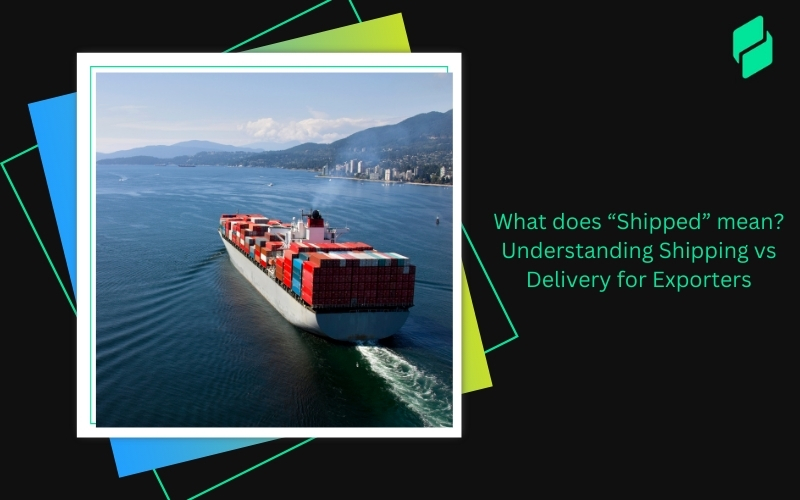Optimize your business: use unlimited savings with Pazago fulfilled now!
Get Started ->Did you know that 68% of businesses report failed or late deliveries as a "significant cost" to their operations? This statistic highlights a major issue faced by companies around the world. For Indian exporters, delays or incomplete shipments can lead to lost contracts, damaged reputations, and costly fines.
A key way to track and improve delivery performance is OTIF (On-Time In-Full). It's a simple metric that shows how reliably your supply chain is meeting customer expectations. When OTIF scores are high, it indicates efficient operations, satisfied customers, and a reliable business. But when those scores fall short, the impact can be severe, both financially and reputationally.
In this blog, we will explore why OTIF matters, how it can be calculated, and how you can improve your own OTIF performance to stay ahead of the competition. Ready to boost your on-time delivery and keep your customers happy? Keep reading to find out how you can achieve this.
What is OTIF & Why Does It Matter?

OTIF stands for On-Time In-Full, a metric used to measure the reliability of your deliveries. It tracks whether your shipments arrive on time and with the correct quantities as ordered. For Indian exporters, this metric is crucial because it directly influences customer satisfaction, repeat business, and supplier relationships.
OTIF acts as a benchmark for operational excellence for companies exporting goods, especially internationally. Buyers want to be certain that their orders will arrive as promised, and the better you perform, the more likely you are to secure future contracts. OTIF is essential in maintaining healthy business relationships and sustaining growth.
Knowing your OTIF score is the first step toward improving it. Let's take a look at how it's calculated.
Also Read: Tracking and Measuring Supply Chain Performance Metrics
How to Calculate OTIF (Formula & Examples)

OTIF is measured by evaluating two key factors: on-time delivery and in-full delivery. A shipment is considered successful only if it meets both conditions. If a delivery is late or missing items, it does not count toward a company's OTIF score.
OTIF Formula:
OTIF (%) = (Number of orders delivered on time and in full / Total number of orders) × 100
For example, if an exporter ships 500 orders in a month, but only 400 of those arrive on time with the correct quantity, the OTIF score would be:
OTIF = (400 / 500) × 100 = 80%
This means that 80% of the shipments met the expected delivery standards. A higher OTIF percentage indicates a more reliable supply chain, while a lower percentage highlights potential inefficiencies that need attention.
What is Considered a Good OTIF Score?
Industry benchmarks for OTIF vary by sector and region. However, many global retailers expect their suppliers to maintain an OTIF score of at least 95%. Falling below this threshold can lead to penalties, contract losses, or additional shipping costs to correct delayed or incomplete orders.
For Indian exporters, achieving a high OTIF score is especially important when dealing with international buyers who have strict supply chain requirements. Improving OTIF can help avoid late fees, increase customer confidence, and strengthen business partnerships.
Now that we've covered how OTIF is measured, let's look at the common challenges that prevent businesses from achieving high OTIF scores.
Also Read: Supply Chain Assessment Tool - Pazago Insights
Key Challenges in Achieving a High OTIF Score

Maintaining a high OTIF score is easier said than done. Exporters face several challenges that can disrupt supply chains and affect delivery performance. Understanding these issues is the first step toward improving OTIF.
- Supply Chain Delays
Raw material shortages, production slowdowns, and supplier inefficiencies can lead to missed delivery timelines. If a manufacturer delays production, shipments may not be ready on schedule, affecting on-time performance.
- Logistics Stoppages
Transportation is one of the biggest hurdles for Indian exporters. Port congestion, customs delays, and unpredictable shipping schedules can make it difficult to meet delivery commitments. Limited carrier availability and rising freight costs add to the complexity.
- Inventory Mismanagement
Stockouts and overstocking can disrupt OTIF performance. If inventory levels are not accurately tracked, exporters may struggle to fulfill orders in full. Poor warehouse organization and slow order processing can also result in partial or delayed shipments.
- Regulatory and Taxation Barriers
Complex export documentation, compliance with trade regulations, and taxation policies such as GST can create roadblocks. Any errors in paperwork or delays in customs clearance can cause shipments to miss their delivery deadlines.
- Lack of Real-Time Visibility
Without proper tracking systems, exporters have limited control over shipments once they leave the warehouse. Unexpected disruptions, such as weather-related delays or last-minute order changes, can impact on-time delivery if they are not addressed proactively.
Each of these challenges can lower OTIF scores and affect customer satisfaction. However, with the right strategies, exporters can overcome these issues and improve their performance.
Also Read: Understanding the Meaning and Impact of Logistical Issues
Practical Steps to Improve Your OTIF Score

Improving your OTIF score requires a strategic approach, focusing on the entire supply chain. Here are several practical steps you can take to increase your chances of meeting on-time, in-full delivery standards:
- Improve Communication with Suppliers and Partners
A seamless flow of information is crucial to meeting delivery deadlines. Staying in touch with suppliers, manufacturers, and logistics partners can help spot and fix problems before they affect your OTIF score. Use collaborative tools to ensure that everyone involved in the supply chain is aligned on timelines, order quantities, and delivery expectations.
- Optimize Inventory Management
Accurate inventory management is essential to making sure orders are fulfilled accurately and completely. By using up-to-date tools like Inventory Management Systems (IMS) and Enterprise Resource Planning (ERP) software, you can track stock levels as they happen, ensuring nothing is missed. By predicting demand more accurately and keeping the right amount of stock, you can avoid running out of products or ending up with excess inventory, both of which can cause shipment delays or incomplete orders.
- Simplify the Shipping Process
Efficiency in shipping can drastically improve OTIF performance. To achieve this, review your shipping routes and timelines regularly. Opt for more reliable and faster carriers where possible, and ensure that your team is well-versed in handling shipping documentation to avoid customs delays. Consider partnering with third-party logistics (3PL) providers who specialize in cross-border shipping to avoid bottlenecks and reduce transportation delays.
- Use Technology for Real-Time Tracking
Invest in real-time tracking systems to monitor the status of your shipments throughout their journey. By gaining visibility into potential delays, you can take corrective actions quickly. For instance, if a shipment is delayed at a port or stuck in customs, you can proactively communicate with the customer, minimizing the impact on their satisfaction.
- Adopt Lean Manufacturing Principles
Lean manufacturing focuses on reducing waste and making production more efficient. By adopting lean principles, you can ensure that products are made in the most efficient manner possible, reducing delays due to production inefficiencies. For Indian exporters, this might mean improving factory floor operations or addressing issues that lead to product defects, which in turn improves both the speed and quality of deliveries.
- Ensure Regulatory Compliance
Ensure you are always updated with the latest trade regulations and documentation requirements. Delays due to customs clearance or missing documents can significantly hurt your OTIF score. Working closely with customs brokers and staying informed about changing export regulations is critical.
- Set Realistic Delivery Expectations
Setting realistic delivery timelines helps manage customer expectations and prevents promises from being broken. Be transparent with customers about potential delays, especially when dealing with international shipments. Over-promising and under-delivering is a quick way to damage customer trust and negatively impact your OTIF score.
By applying these steps, you can gradually improve your OTIF score and make your deliveries more reliable. While challenges will always exist in the supply chain, proactive planning and the right tools can help minimize disruptions and ensure that your shipments arrive on time and in full. Let's see how Pazago makes this easier.
Also Read: Logistics Management with Software
How Pazago Simplifies Export Logistics

Managing international shipments comes with challenges, but Pazago helps exporters stay ahead by reducing delays and improving efficiency. Here's how:
- Centralized Document Management: Stores invoices, certificates of origin, and other key documents in one place for quick access and error-free processing.
- Reliable Cross-Border Shipping: Optimizes shipping routes to ensure cost-effective and timely deliveries, reducing missed deadlines.
- Real-Time Shipment Tracking: Provides live updates on shipment status, allowing you to anticipate and address potential delays.
- Quality Inspections: Ensures goods meet quality and compliance standards before shipping, reducing rejection risks at customs.
- Smart Financial Solutions: Simplifies payments, currency conversions, and financing to improve cash flow and prevent transaction-related delays.
By integrating these solutions, Pazago helps exporters reduce inefficiencies, lower risks, and meet delivery expectations consistently.
Conclusion
Ensuring shipments arrive on time and in full is critical for exporters looking to build strong relationships and secure repeat business. Late or incomplete deliveries lead to penalties, dissatisfied customers, and lost opportunities. Exporters can significantly improve their shipping performance by improving communication, optimizing inventory, and using technology for real-time tracking.
Pazago takes the guesswork out of logistics by offering centralized document management, optimized shipping routes, real-time tracking, and seamless financial solutions. These tools help exporters stay compliant, minimize delays, and easily meet customer expectations.
Ready to take control of your export operations? Book a demo today and see how it can help you simplify your shipments and improve delivery performance.


.png)








